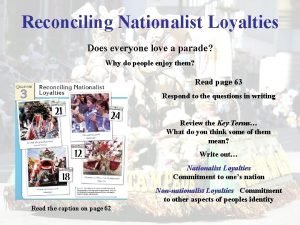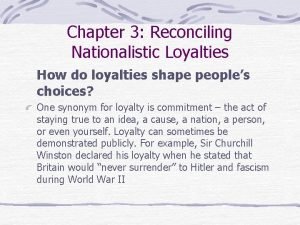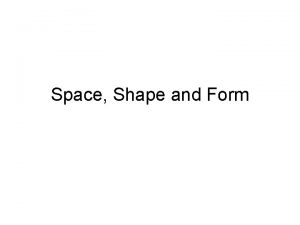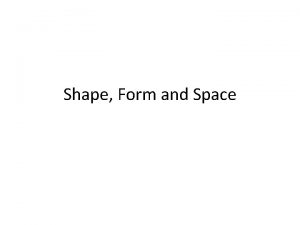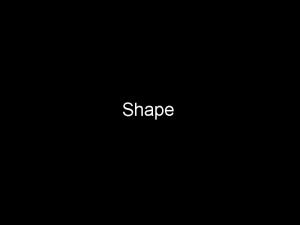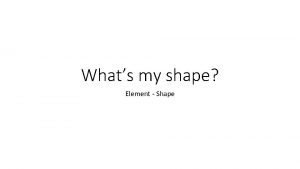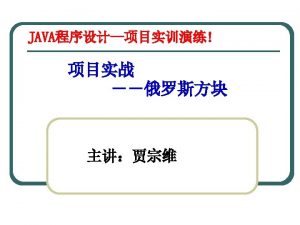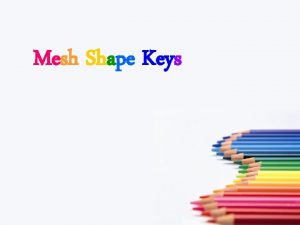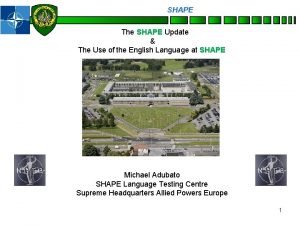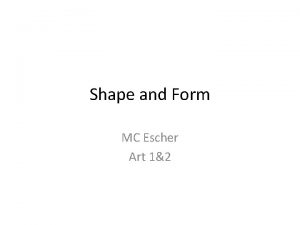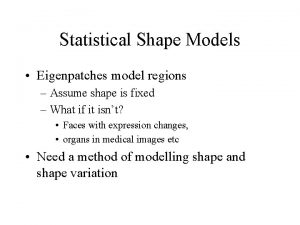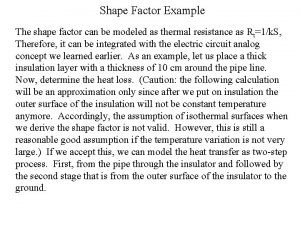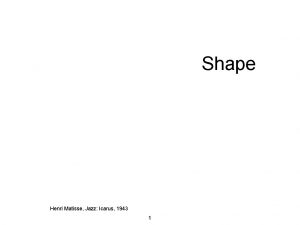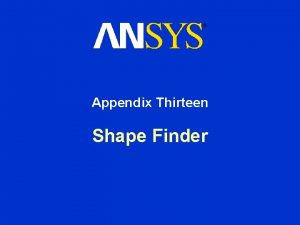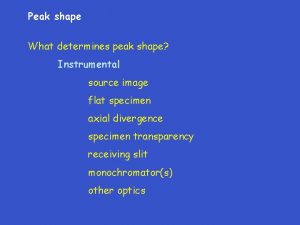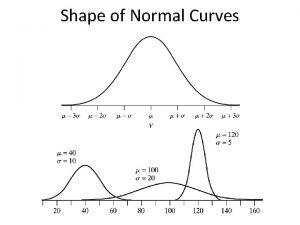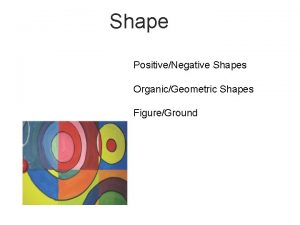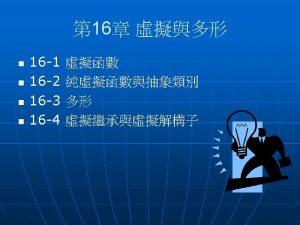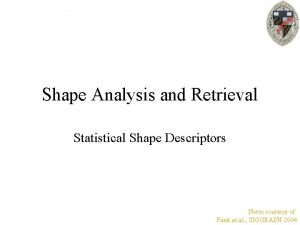Modeling the Shape of People from 3 D


![Space of Human Shapes movie [scape movie] Space of Human Shapes movie [scape movie]](https://slidetodoc.com/presentation_image_h/eb38ddb18299231353cb22e02e7330a1/image-3.jpg)















![Local surface signatures n Use spin-images [Johnson ’ 97] n n n 2 D Local surface signatures n Use spin-images [Johnson ’ 97] n n n 2 D](https://slidetodoc.com/presentation_image_h/eb38ddb18299231353cb22e02e7330a1/image-19.jpg)

![CC movie [movie] CC movie [movie]](https://slidetodoc.com/presentation_image_h/eb38ddb18299231353cb22e02e7330a1/image-21.jpg)







![Parts movie [parts. gif] Parts movie [parts. gif]](https://slidetodoc.com/presentation_image_h/eb38ddb18299231353cb22e02e7330a1/image-29.jpg)











- Slides: 40

Modeling the Shape of People from 3 D Range Scans Dragomir Anguelov AI Lab Stanford University Joint work with Praveen Srinivasan, Hoi-Cheung Pang, Daphne Koller, Sebastian Thrun

The Dataset n Scans n n 4 views, ~125 k polygons ~65 k points each Problems n n Missing surface Drastic pose changes
![Space of Human Shapes movie scape movie Space of Human Shapes movie [scape movie]](https://slidetodoc.com/presentation_image_h/eb38ddb18299231353cb22e02e7330a1/image-3.jpg)
Space of Human Shapes movie [scape movie]

The Modeling Pipeline

Talk outline n Scan registration n n Rigid Nonrigid Correlated correspondence Decomposition into approximately rigid parts Learning a deformable human model

Talk outline n 3 D Scan registration n n Rigid Nonrigid Correlated correspondence Decomposition into approximately rigid parts Learning a deformable human model

Rigid Scan Registration n Aligning point clouds X and Z n n n Match each point in Z to its closest point in X Compute the best rigid transformation T which aligns the matching pairs Transform the points of cloud X by T Repeat Iterative Closest Point (ICP) algorithm [Besl et al ’ 92]

ICP matching step n Objective (using n obtains n Substituting the above for s yields a system linear in R Choose a parameterization of R (quaternions q) and solve n Exact solution n n Setting Overall, ICP converges to a local minimum of the energy )

Nonrigid Registration Example n Deformable template model X n n Set of deformable springs Nonrigid registration n n Deforms X to match a scan Z Minimizes the deformation of X

Generative Model Deformation / Transformation Q Model mesh X Data Generation / Correspondences C Transformed mesh X’ Data mesh Z Goal: Given meshes X and Z, recover transformation Q and correspondences C

Data mesh generation Transformed Model Data Correspondence ck specifies which point in X’ generates point zk: X’ Z

Nonrigid ICP failure example n Nonrigid ICP attempts to maximize X n Z Local Minima n Poor transformation and correspondence estimates reinforce each other

Correlated correspondences n Nonrigid-ICP decorrelates the correspondences n Correspondences are conditionally independent given Q n n c 1 c 2 n If Q is unknown, correspondences are correlated E. g. nearby points in Z should be mapped to nearby points in X The search space is exponential for the general registration problem

Correlated Correspondence Z n n X n Compute an embedding of mesh Z into model X The domain of ci is the set of possible (discrete) matches for zi on the surface of X The solution is a consistent assignment to all correspondence variables C

Correlated Correspondence Z n n n X Edge is generated from some edge in X Prefer values of c 1, c 2 according to the deformation of X they induce Doing this for all edges in Z results in a Markov network over C (c 1) c (c 1, c 2) 1 (c 1, c 3) c (c 2) c 2 (c 2, c 3) 3 (c 3)

Pairwise Markov Networks i yi ij yj {1, …, K} n Inference is Markov Nets is generally intractable n Good approximate algorithms exist (belief propagation)

CC Potentials (c 1) c (c 1, c 2) 1 (c 1, c 3) c (c 2) c 2 (c 2, c 3) 3 (c 3) n n Deformation potentials Spin image* potentials n n Quantify the similarity of the local surface around two matching points Geodesic Potentials *[Johnson+Hebert ’ 97]

Geodesic potentials Z n X Nearby points in Z must be nearby in X n Constraint between each pair of adjacent points zk, zl Z n X Distant points in Z must be distant in X n Constraint between each pair of distant points zk, zl (farther than 5 r) r resolution of mesh X
![Local surface signatures n Use spinimages Johnson 97 n n n 2 D Local surface signatures n Use spin-images [Johnson ’ 97] n n n 2 D](https://slidetodoc.com/presentation_image_h/eb38ddb18299231353cb22e02e7330a1/image-19.jpg)
Local surface signatures n Use spin-images [Johnson ’ 97] n n n 2 D Histogram of distances from an oriented reference point Rotationally-invariant / Robust under clutter and occlusion / Compressible (PCA) Potential f(ck = i) encodes how well the signature of point zk matches the signature of point xi in the model: n

Results: Human poses dataset Model Cyberware scans Registrations Art. Model II • 4 markers were used on each scan to avoid the need for multiple initializations of Loopy-BP • Art. Model I found using 20 registered scans • Art. Model II found using 44 registered scans
![CC movie movie CC movie [movie]](https://slidetodoc.com/presentation_image_h/eb38ddb18299231353cb22e02e7330a1/image-21.jpg)
CC movie [movie]

Talk Outline n Scan registration n n Rigid Nonrigid Correlated correspondence Recovering the articulated skeleton Learning a deformable human model

Recovering the skeleton Input: models, correspondences Output: rigid parts, skeleton

Probabilistic Generative Model a Part labels Points … 1 … x 1 Transformed Model Instance a x … 1 Points aj = Part (xj) T N y Point labels Transformations N b 1 y N b. K z 1 … z K bk = Model. Point (zk)

Part Properties n Parts are preferably contiguous regions n n Adjacent points on the surface should have similar labels Enforce this with a Markov network: If i, j are connected in model mesh 1 > > 0. 5 a a 1 a 2 3

Iterative Optimization n Hard EM n n Given transformations to get , perform min-cut inference Given labels , solve for rigid transformations

Results: Puppet articulation

Results: Arm articulation
![Parts movie parts gif Parts movie [parts. gif]](https://slidetodoc.com/presentation_image_h/eb38ddb18299231353cb22e02e7330a1/image-29.jpg)
Parts movie [parts. gif]

Talk Outline n Scan registration n n Rigid Nonrigid Correlated correspondence Recovering the articulated skeleton Learning a deformable human model

Pose variation Modeling Human Shape Body-shape variation

Representation of pose deformation Rigid articulated deformation Pose deformation Given estimates of R, Q, synthesizing the shape is straightforward :

Learning non-rigid pose deformation n n For each polygon, predict entries of nearest 2 joints (represented as twists Linear regression parameters : from rotations of ).

Learning body-shape deformation n Include also change in shape due to different people: n Do PCA over body-shape matrices :

Shape completion n Process: n n n Add a few markers (~6 -8) Run CC algorithm to get >100 markers Optimize for pose/body -shape parameters and non-rigid surface

Mocap shape completion

Recap n Algorithms for registration between two surfaces n ICP algorithm iterates between finding corresponding points between two scans and computing the transformation between them n n n CC explicitly encodes correlations between correspondence variables n n n Rigid variant (6 unknown DOF) Nonrigid variant (6 Number of polygons DOF) Essential when we have poor initial transformation estimate Exponential complexity, approximate algorithm Modeling humans n Decouple effects of pose and different physique on shape deformation

The end

Geodesic Potentials: close Z n X Nearby points in Z must be nearby in X n Constraint between each pair of adjacent points zk, zl

Geodesic Potentials: far Z n X Distant points in Z must be distant in X n Constraint between each pair of distant points zk, zl
 Helen c. erickson nursing theory
Helen c. erickson nursing theory Relational vs dimensional data modeling
Relational vs dimensional data modeling Aerodynamic shapes
Aerodynamic shapes Shape matching and object recognition using shape contexts
Shape matching and object recognition using shape contexts Bolongie
Bolongie Contending nationalist loyalties
Contending nationalist loyalties How do nationalist loyalties shape people's choices
How do nationalist loyalties shape people's choices Tư thế worms-breton
Tư thế worms-breton Thế nào là số nguyên tố
Thế nào là số nguyên tố Vẽ hình chiếu vuông góc của vật thể sau
Vẽ hình chiếu vuông góc của vật thể sau đặc điểm cơ thể của người tối cổ
đặc điểm cơ thể của người tối cổ Các châu lục và đại dương trên thế giới
Các châu lục và đại dương trên thế giới Thế nào là hệ số cao nhất
Thế nào là hệ số cao nhất Sơ đồ cơ thể người
Sơ đồ cơ thể người Bổ thể
Bổ thể ưu thế lai là gì
ưu thế lai là gì Tư thế ngồi viết
Tư thế ngồi viết Bàn tay mà dây bẩn
Bàn tay mà dây bẩn Mật thư anh em như thể tay chân
Mật thư anh em như thể tay chân Chúa yêu trần thế alleluia
Chúa yêu trần thế alleluia Tư thế ngồi viết
Tư thế ngồi viết Thẻ vin
Thẻ vin Thể thơ truyền thống
Thể thơ truyền thống Các châu lục và đại dương trên thế giới
Các châu lục và đại dương trên thế giới Từ ngữ thể hiện lòng nhân hậu
Từ ngữ thể hiện lòng nhân hậu Tỉ lệ cơ thể trẻ em
Tỉ lệ cơ thể trẻ em Hổ sinh sản vào mùa nào
Hổ sinh sản vào mùa nào Diễn thế sinh thái là
Diễn thế sinh thái là Vẽ hình chiếu vuông góc của vật thể sau
Vẽ hình chiếu vuông góc của vật thể sau Thế nào là giọng cùng tên? *
Thế nào là giọng cùng tên? * 101012 bằng
101012 bằng Các môn thể thao bắt đầu bằng tiếng chạy
Các môn thể thao bắt đầu bằng tiếng chạy Hình ảnh bộ gõ cơ thể búng tay
Hình ảnh bộ gõ cơ thể búng tay Lời thề hippocrates
Lời thề hippocrates đại từ thay thế
đại từ thay thế Quá trình desamine hóa có thể tạo ra
Quá trình desamine hóa có thể tạo ra Công của trọng lực
Công của trọng lực Thế nào là mạng điện lắp đặt kiểu nổi
Thế nào là mạng điện lắp đặt kiểu nổi Gấu đi như thế nào
Gấu đi như thế nào Các loại đột biến cấu trúc nhiễm sắc thể
Các loại đột biến cấu trúc nhiễm sắc thể Thế nào là sự mỏi cơ
Thế nào là sự mỏi cơ





